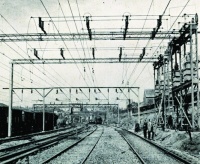
Electrification of the rail network in the UK has taken place gradually over time and today forms a key part of the government’s drive to lower transport emissions. In 1960 The Engineer took a look at the first British railway electrification on the Manchester-Crewe line, which was seen as an important step in creating a new electric rail infrastructure in the UK.
’In the course of the press inspection of the line, the ability of the type A locomotive to reach their nominal maximum of 100 mph was demonstrated,’ reported The Engineer.
’[The] locomotive, one of those supplied by The English Electric Company, covered some five miles with a five-coach train at a minimum of 97 mph and reached 102.3 mph while still accelerating between Goostrey and Chelford.’
The previous decade had seen a preference for 25kV 50 Hz in place of 1,500 V DC and later became the standard for all mainline electrification outside the south of England.
To convert the track to 25KV, 82 out of the 92 bridges on the route had to be heightened; three tunnels at Stockport were opened; and two new bridges were constructed to carry roads over the railway cutting. London Road station was also extensively rebuilt and renamed Manchester Piccadilly.
“Good results have been obtained in insulation with Fibreglass”
The article continued: ’Experiments are being made with various methods of insulation and good results have been obtained with “Fibreglass”.
This material has been used for the cantilever arms themselves at some structures… Overhead structures are earthed by bonding to the running rails where rails are not carrying track circuit currents for signalling.’




Nanogenerator consumes CO2 to generate electricity
Nice to see my my views being backed up by no less a figure than Sabine Hossenfelder https://youtu.be/QoJzs4fA4fo